Mumbai: Despite made-in-India drugs making international headlines for their poor quality multiple times over the last few years, the incidences of ‘official action indicated (OAI)’ after US Food and Drug Administration (USFDA) inspections have come down by 50 percent over the past decade, a new report shows.
The OAI by the FDA is typically issued when it finds serious and objectionable conditions, or practices, during an inspection that may lead to import alerts, warning letters or drug recalls.
According to the joint report by Indian Pharmaceutical Alliance (IPA), and strategy and consulting firm McKinsey & Company, released Thursday during the 10th Global Pharmaceutical Quality Summit held by IPA, there has been a 27 percent decline in European Medicines Agency (EMA) non-compliance between 2013-14 and 2023-24. Non-compliance with EMA standards, too, indicates issues with quality parameters and manufacturing processes by drugmakers.
IPA is a network of top 23 Indian pharma companies, including the likes of Sun Pharma, Dr Reddy’s Laboratories, Lupin, Torrent and Glenmark.
The report shows that the total number of FDA inspections carried out globally in 2014 were 1,840, which resulted in six percent OAI. In 2024, on the other hand, the number of global inspections were 940, leading to 14 percent OAI.
In India, in 2014, there were 109 inspections, of which 23 percent resulted in OAI, while in 2024, the USFDA carried out 166 inspections, of which 11 percent resulted in OAI.
The report, however, did not have cumulative data on OAI between 2014 and 2024, which would have given a comprehensive picture of the compliance by Indian companies.
“There was some rise in OAI immediately after the COVID-19 period because the inspections were carried out after a gap and some complacency had set in, but overall the industry has come a long way in improving quality parameters,” IPA secretary general Sudarshan Jain told ThePrint.
Worryingly, the report also shows, while there has been considerable improvement in Good Manufacturing Practices (GMP) training, capabilities and core processes, the three areas saw an increase in the share of observations during inspections.
These included practices such as aseptic practices, contamination and unavailability of written procedures, facilities and ancillary infrastructure, and gaps in maintenance of facility to ensure sanitary conditions, apart from failure to thoroughly review any unexplained discrepancy.
In case of aseptic practices and contamination, the observations grew by 25 percent, while in terms of ensuring sanitary conditions, they grew by 19 percent, the figures show.
“We totally understand and acknowledge that there are areas where we need to improve and we are working on them,” Jain said.
World leader in generics
According to the report, India meets 20 percent of global demand for generics, including over 40 percent of US generic needs, and 25 percent of medicines in the UK.
At the same time, the report says, manufacturing costs in India have stayed 30-35 percent lower than in the US and Europe due to low-cost human capital, companies’ collective efforts toward industry-leading cost and productivity performance, and accelerated digital adoption.
The report comes days after a study by a top US university highlighted that the number of serious adverse events linked to generic drugs made in India was 54 percent higher than for those made in the US.
The latest report, however, says that stronger investments in world-class infrastructure have led India to surpass the US in the number of FDA-registered generic manufacturing sites, having grown at 2.6 percent CAGR (Compound Annual Growth Rate).
The country, in 2024, had a network of 752 FDA-approved, 2,050 World Health Organisation-GMP certified, and 286 plants approved by the European Directorate for the Quality of Medicines and Healthcare (EDQM).
As of last year, India has emerged as the world’s largest supplier of generic medicines, with a nine percent pharma export growth rate—nearly double the global average—the report adds. Within the industry, performance has started plateauing, while the bar for quality excellence continues to evolve.
The report, however, also notes that India’s pharmaceutical industry is at a tipping point—emerging trends in Indian and global landscapes could disrupt the current environment, but could also lead to the next horizon of opportunities for the industry.
(Edited by Mannat Chugh)
Also Read: After seperating teen from limbs of parasitic twin, AIIMS doctors flag lack of prenatal screenings






